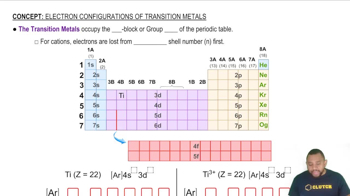Here are the essential concepts you must grasp in order to answer the question correctly.
Electron Configuration
Electron configuration describes the distribution of electrons in an atom's orbitals. It is represented by a series of numbers and letters indicating the energy levels and sublevels occupied by electrons. For example, the notation 'nd10' indicates that the d subshell is fully filled with 10 electrons, which is characteristic of transition metals.
Recommended video:
Electron Configuration Example
Transition Metals
Transition metals are elements found in the d-block of the periodic table, known for their ability to form variable oxidation states and colored compounds. They typically have partially filled d orbitals, but when they form +2 ions, they often lose their outermost s electrons first, leading to stable electron configurations such as nd10.
Recommended video:
Ionic Charge and Stability
Ionic charge refers to the net electrical charge an atom carries after losing or gaining electrons. A +2 ion indicates that the atom has lost two electrons, which can lead to a more stable electron configuration. For example, transition metals like copper (Cu) and zinc (Zn) can form +2 ions with a stable electron configuration of nd10, contributing to their chemical properties.
Recommended video:
Intepreting the Band of Stability
 Verified step by step guidance
Verified step by step guidance

